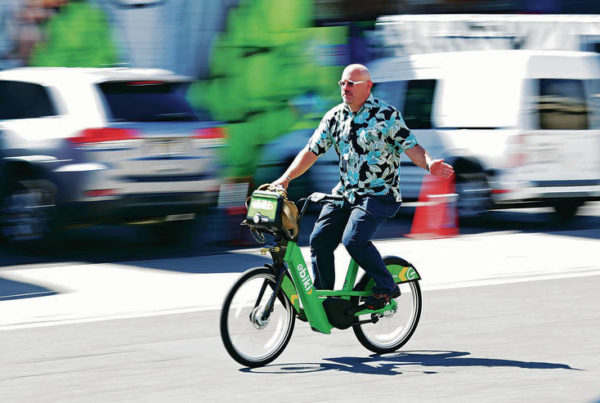Honolulu Star-Advertiser
May 17, 2019
Next month Biki turns two, and operator Bikeshare Hawaii says they have found a “sweet spot” by anticipating rider demand and opening docking space at key locations during crucial times of the day. That has helped increase bike use to an average of 3 rides per bike per day, up from 1.7 in the first six months of operations.
Biki is now the sixth most used bikeshare system in the nation, behind New York City, Chicago, Washington, D.C., Greater Boston and the Bay Area, according to a report from the National Association of City Transportation Officials. Biki had been ranked eighth during its first six months of operation.
The bikesharing program launched on June 28, 2017.
Now officials want to expand into Kalihi-Palama and Kaimuki, add employer discount plans and introduce electric bikes.
“These are very common things on the West Coast, but they’re coming to Honolulu now,” said Todd Boulanger, executive director of Bikeshare Hawaii.
Boulanger said Biki’s has found the ideal distance between each docking station is about 600 yards, or two blocks.
“It’s important that when we place stations, we place them in very visible, easy to get to, easy, safe bike places to be, like Waikiki, Kakaako, because those stations, the average rides per bike per day are higher than three,” he said. “We have some stations – a lot of stations in the Waikiki and Kakaako area that are six, seven rides per day. And we have one station that’s up to 10 rides per day. That’s per bike.
“What we’re finding out is, often a lot of our initial stations are too small,” he added.
Biki has since increased its docking stations from 15 to about 34.
Gradual build up
The Biki buildup started small to remain affordable and manageable and to reduce shock to the community.
“I know a lot of people, in 2017, went to their favorite block and said, ‘Oh my god, the city’s changed overnight,'” said Boulanger. “So we’re to the point where people – when we were installing the Makiki station this last December – instead of saying, ‘What is this?’ People said, ‘I’m so happy you’re here, what took you so long?’ So that’s where the message has really changed.”
Community members can put in a request for a station via Biki’s website. Boulanger said he receives about three to four requests a day.
Currently, there’s around 13,000 recurring riders, but around 100,000 members total that have used the system, according to Boulanger.
Bikeshare Hawaii handles the contract with the city and state, community discussions, pricing, sponsorships, and partners side of the business operation. The nonprofit hired Secure Bike Share Hawaii, a for-profit contractor, to do the maintenance operations, including the mechanical work and station re-locations, according to Boulanger.
To combat peak hours in high-demand areas, officials visit the dock stations to “re-balance” them.
“Biki riding is like the tidal flow of the ocean,” Boulanger said. “So we generally know the time of day where people want to go or where they want to park. So we try to predict that. … Downtown by (Hawaii Pacific University), or at City Hall … we know that about 8 a.m. in the morning, people want to go to work or classes. So we try to make sure the docks are open for people to park. Or conversely, at the end of the day at those same places, we want to make sure those bikes are ready to go home.”
Boulanger said Biki has a higher average of female riders than most bikeshare systems in the nation at 44%, compared to 30% or less.
Around 36 million trips were taken on station-based bike share systems nationwide, according to the NACTO report.
Routine maintenance
With over a million Biki rides taken in 2018, maintenance and repairs are routine for Secure Bike Share Hawaii, which handles maintenance, repairs and customer service for Biki.
When riders return their bikes, there’s a mechanic button they can push that tells Biki HQ officials that the bike needs work.
Employees then visit the station to gauge whether the issue is minor and can be fixed on site or more serious and needs if to be brought back to the Secure Bike Share Hawaii facility for repair. Each time a bike is brought into the shop, it also gets cleaned. On average, a bike comes into the shop three to four times a year to get serviced at one of the four service stations set up, according to Secure Bike Share Operations Superviser Jonathan Alexander.
“That’s a much more frequent cycle than some of the other cities,” Boulanger said. “It may only be once a year for some other city systems.”
Alexander added that the docking stations get cleaned once every two months on average. Bikes also have annual safety checks.
There’s usually an average of one or two bikes “lost” or “loose” every day.
“Most Biki’s make it back because we either find them – we see them because they’re so distinctive and you can’t use the parts on other bikes,” said Boulanger, who recalled how one Biki bike was found in Kapolei. “That was a security feature that was designed for the bike. And so most people, if they find a Biki, they … return it to us … I mean, there’s more car theft in Honolulu than Biki theft.”
Biki employees have a system that monitors how long each bike has been in use in real time. Once the bike has been out for a few hours, a Biki customer service employee will call the customer and make sure everything is OK.
When a bike is returned to a docking station, the rider must wait for a green light that shows it has been properly docked. In some cases, there have been customers who thought they docked the bike but didn’t wait to see the green light turn on.
“Don’t listen for the sound, it’s the green light or nothing,” Boulanger said.
Boulanger added that customers do have to pay for the time the bike isn’t docked, despite any issues.
“Leaving a Biki bike unlocked at a store or not completely docked … is like leaving your rental car unattended with its engine running or parked with its keys in the ignition and windows open,” Boulanger said.
Customer service
Biki’s customer service call center is open everyday from 6 a.m. to 11 p.m. and get an average of about 175 calls a day with questions ranging from flat tires to memberships.
There’s also a “Biki Basics” class.
Boulanger said one car parking stall can house around eight Biki bikes.
He recounted how at last year’s Lantern Floating Hawaii ceremony on Memorial Day at Ala Moana Beach Park, Biki had a valet service where employees would take the bike and park it in a certain area.
“We had 300 ins – parks – and 300 outs,” Boulanger said. “So imagine what would happen to the park if they tried to build a parking lot or parking structure for that peak demand? We take the peak demand so the park can stay green.”
Boulanger mentioned that Bikeshare Hawaii gets its income strictly from donations by corporate sponsors, which are listed on the bike. Revenue from customers goes to Secure Bike Share Hawaii to reimburse the purchase costs of the bikes.
Since the beginning, the nonprofit has gotten a total of over $1 million from the City and County of Honolulu, over $1.1 million from the state, less than $5 million from private loans and investments led by Secure Bike Share Hawaii, over $2.2 million in federal funds, and over $400,000 in donations from local businesses.
https://www.staradvertiser.com/2019/05/17/hawaii-news/biki-finds-the-sweet-spot/







